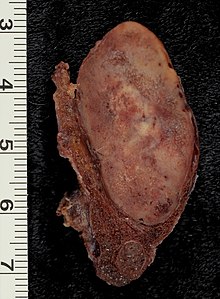Thyroid adenoma
The benign adenoma is the most common type of thyroid tumor . It is a neoplasm composed of epithelial thyroid cells with a surrounding capsule that can grow up to 10 cm in size. The histological breakdown (follicular, trabecular, light-cell adenomas, etc.) is of little clinical significance; only the so-called autonomic adenomas become noticeable earlier because of their hormonal activity and require treatment. As adenomas grow in size, they develop cysts, septa, and calcifications called regressive changes.
Follicular adenomas have a relevant (2–5%) risk of degeneration. The sonographic and radiologic imaging can not in all cases of certain thyroid carcinoma disconnect. Therefore, larger, scintigraphically cold (no hormone producing) thyroid nodules should usually be removed and small (up to approx. 1 cm) should be checked at least regularly with imaging and possibly biopsied.
Almost all adenomas have the follicle cells as their origin. The C-cell adenoma is a very rare variant that was only described in 1988, in a sense the benign version of medullary carcinoma .
Sonography of a nodule with regressive cysts
Scintigraphy of a cold lump on the right
Fine needle biopsy of an adenoma
literature
- KW Schmid, S.-Y. Sheu, R. Görges, C. Ensinger, M. Tötsch: Tumors of the thyroid. Pathologist 2003/5 doi : 10.1007 / s00292-003-0630-0
Individual evidence
- ↑ American Thyroid Association: ATA guidelines 2015 (PDF), Thyroid 2015 doi : 10.1089 / thy.2015.0020 .
- ↑ T. Kodama, T. Okamoto et al. a .: C cell adenoma of the thyroid: a rare but distinct clinical entity. In: Surgery. Volume 104, Number 6, December 1988, pp. 997-1003, PMID 3194851 .



